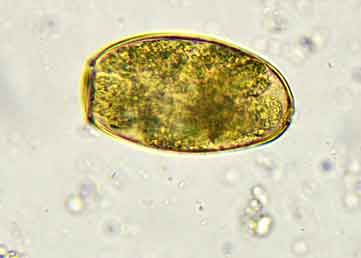Lung Flukes
(Paragonimus spp.)
Lung flukes are trematodes that can infect a wide range of definitive hosts, including cats. They are zoonotic.
Distribution
Paragonimus westermani is found in far East Asia and the Philippines. Paragonimus pulmonalis is found in Japan, Korea and Taiwan. Paragonimus heterotremus is found in China, India, Thailand, Vietnam and Laos. Paragonimus skrjabini is found in China, Japan, India and Vietnam [1]. Paragonimus kellicotti is found in North America. Paragonimus mexicanus is found in Mexico, Central America, and South America [2].
Clinical signs
Heavy P. westermani infection in cats may cause pneumothorax with pleural effusion as early as 3-4 weeks post infection due to the migration of juvenile worms through the diaphragm, pleura and lung parenchyma prior to becoming encapsulated as adults [3]. A fatal case of P. heterotremus infection has been reported in a cat in Thailand [2]. Occasional coughing, as well as bouts of paroxysmal coughing and dyspnoea due to pneumothorax from rupture of lung cysts has been described in cats infected by P. kellicotti [4].
Diagnosis
Lung fluke infections can be confirmed by faecal sedimentation. Eggs, which are operculated and contain a fully developed miracidium (Fig. 1), are approximately 70-100 x 39-55 μm in P. westermani, 85-100 x 40-58 μm in P. pulmonalis, 86 x 48 μm in P. heterotremus, 80-100 x 55-65 µm in P. kellicotti and 79 x 48 μm in P. mexicanus [1].
Treatment
Off-label use of praziquantel at 100 mg/kg PO twice daily for 2 days was effective against P. westermani in a heavily infected cat. Off-label use of praziquantel 23 mg/kg PO three-times daily for 3 days was effective in treating cats experimentally infected by P. kellicotti.

Figure 1. Paragonimus sp. egg with a distinct operculum (Image credit: Shutterstock)
Prevention and Control
The control of lung fluke infections can be achieved by preventing cats from hunting and eating intermediate hosts and not allowing them to ingest raw crab and crayfish.
Public health considerations
Many species of lung flukes that infect cats have been reported in humans. Cats do not pose a direct zoonotic risk as humans acquire paragonimosis through the ingestion of undercooked crab and crayfish.
References
[1] Blair D, Agatsuma T, Wang W. Paragonimiasis. pp. 117-150 in Murrell KD, Fried B. (Eds) World class parasites. Vol. 11, Food-borne parasitic zoonoses. New York, Springer; 2007.
[2] Bowman DD, Hendrix CM, Lindsay DS, Barr SC. Feline Clinical Parasitology. Iowa State University Press, Ames, USA. 2002.
[3] Im G et al. Pulmonary paragonimiasis: clinical and radiographic studies. Radiographics. 1993;13:575-586.
[4] Peregrine AS, Nykamp SG, Carey H, Kruth S. Paragonimosis in a cat and the temporal progression of pulmonary radiographic lesions following treatment. J Am Anim Hosp Assoc. 2014;50:356-360.
